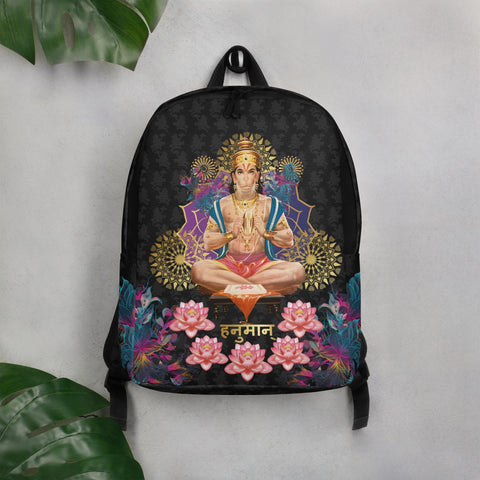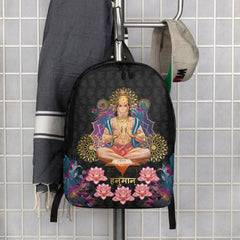The Divine Connection: Lord Hanuman is an Incarnation of Lord Shiva
Posted by Massimiliano Geraci

Exploring the spiritual depths of Hinduism reveals a rich tapestry of divine figures, scriptures and stories that have shaped the beliefs and practices of millions. Among these, the figure of Hanuman stands out as a beacon of devotion and strength.
A common curiosity among devotees and scholars alike revolves around the mysterious nature of his birth and his connection to Lord Shiva, one of Hinduism's principal deities. This intrigue often leads to questions about the essence of divinity, avatarhood, and spirituality in Hindu thought.
A pivotal fact at the center of this discussion is that Hanuman is considered an incarnation (avatar) of Lord Shiva himself. This notion bridges two significant areas within Hindu theology—Shaivism, centered on Lord Shiva, and Vaishnavism, focused on Lord Vishnu incarnated as Rama.
The blog will explore how this divine connection frames Hanuman's role in the Ramayana, showcases his unmatched attributes, and highlights why he was chosen by Shiva for this earthly journey.
Discover how reverence for Hanuman transcends mere temple worship.
Who is Hanuman?
Hanuman, often hailed as the son of Anjana and Kesari and blessed by Vayu, the wind god, stands out in Hindu mythology for his unwavering devotion to Lord Ram. His birth is celebrated across India, marking him as a divine figure imbued with extraordinary strength, supreme intelligence, and loyalty.
From his mysterious birth through the blessings of several deities including Brahma to his instrumental role in locating Sita during her abduction by Ravana, Hanuman's life story is rich with tales of bravery and devotion.
Acting as Lord Rama's staunchest devotee in the epic Ramayana, Hanuman’s feats encompass a wide range from leaping across oceans to carrying entire mountains for healing herbs. Beyond his physical prowess lies a deep spiritual significance; he embodies selflessness, courage, and pure devotion.
This makes Hanuman a key figure in the narrative of Ramayana and an enduring symbol of Bhakti (devotion) within Sanātana Dharma that inspires millions to this day. Through sacred texts like the Hanuman Chaliss –a set of forty verses sung in praise– followers seek protection and strength from this deity known for his unyielding dedication to righteousness and dharma.

Hanuman's Birth and Parentage
Hanuman ji was born as the son of Añjanā and Kesari, with a divine intervention from Vayu, the wind god, which explains his moniker "son of the wind god." His birth is celebrated across various cultures, highlighting his significance in Hindu mythology.
Añjanā, a celestial nymph (apsara), longed for a child and performed Yajna to please Lord Shiva. In response to her devotion, Lord Shiva incarnated a part of his essence into her offspring. Through Shiva's love, he granted her wish, making Hanuman an incarnation of Lord Shiva. Thus, Lord Shiva appeared in the form of mighty Hanuman, fulfilling Añjanā's prayers.
This connection between Shiva and Hanuman emphasizes his divine origin and unique powers that later define his role in the epic tales.
Without Shiva's blessing, my existence would be devoid of strength. - Hanuman
The tale shifts focus to "The Tale of Hanuman's Mischievous Youth," where these inherited traits from both Vayu and Shiva manifest vividly through various adventures and misadventures.
The Tale of Hanuman's Mischievous Youth
As a young vanara, Hanuman's boundless energy and curiosity led him to mistakenly believe the sun was a ripe fruit in the sky. This audacious act demonstrated his incredible prowess even as a child, showcasing an innate power that hinted at his divine origin.
Blessed by the wind god and born with extraordinary strength, Hanuman's leap towards the sun is celebrated in myths as a testament to his fearless nature and celestial lineage.
Encounters with sages and gods also marked Hanuman’s youth with tales of mischief turning into lessons of humility and devotion. One memorable incident involved the sage Durvasa, who placed a minor curse on Hanuman for his mischievous behavior, which made him forget about his immense powers until reminded by others.
This episode underscores how even divine figures like Hanuman are subject to life’s trials but emerge stronger through devotion and loyalty—a recurring theme that resonates within the narratives of Hindu epics such as Ramcharitmanas and Shiva Purana.
The Role of Hanuman in the Ramayana
Transitioning from Hanuman's youthful antics, his role in the Ramayana emerges as pivotal and profound. Tasked with locating Sita, who Ravana had abducted, Hanuman demonstrates unparalleled devotion and bravery.
His journey leads him to Lanka, where he not only finds Sita but also reassures her of Rama's imminent rescue efforts. This act alone cements Hanuman's status as an embodiment of loyalty and courage.
Hanuman’s contributions extend beyond mere diplomacy; during the epic battle between Rama and Ravana, when Rama's brother Lakshmana is severely wounded, it is Hanuman who undertakes a critical mission to retrieve the life-saving herb Sanjivani from the Dronagiri range in the Himalayas.
Displaying miraculous strength, he carries an entire mountain back to ensure Lakshmana’s recovery, enabling their army to persist in combat against Ravana. Through these acts of fearlessness and unwavering dedication, Hanuman becomes celebrated for his devotion not just to Lord Rama but as a symbol of faithfulness across generations within Hindu tradition.
Who is Lord Shiva?
Lord Shiva stands as a pivotal deity in Hinduism, revered as the Destroyer within the Trimurti, embodying creation, preservation, and destruction. His presence transcends simple categorization; rather, he embodies the complex interplay of life and death, regeneration and obliteration.
Manifesting in various forms such as Lord Rudra—a fierce aspect associated with storms and wind—and the serene ascetic dwelling on Mount Kailash, Shiva's multifaceted nature reflects his profound significance.
Devotees often venerate him through practices like chanting the Rudra mantra or observing fasts during Shravan month to seek his blessings for prosperity and protection.
Shiva reconciles contradictions: creator and destroyerer, yogi and householder.
The devotion to Lord Shiva is deeply embedded within various religious texts including Puranas where he is depicted not just as a god but also a teacher of Yoga. In fact, festivals like Maha Shivratri celebrate his cosmic dance (Tandava) symbolizing creation, preservation, and dissolution of the universe.
This festival galvanizes millions who follow rigorous rituals with fervent enthusiasm—fasting by day followed by night-long vigils—showcasing unwavering dedication towards attaining spiritual elevation under Shiva’s guidance.
Through these acts of devotion lies an intricate tapestry tying humanity to divinity; encapsulating Lord Shiva’s essence as both a tangible figure worthy of reverence in mythology and an abstract embodiment guiding principles underlying existence itself.
The Significance of Shiva in Hinduism
Shiva stands as a pivotal deity in Hinduism, embodying the cycle of creation, preservation, and destruction. His significance transcends mere worship, influencing various domains such as spirituality, art, and culture.
Referred to as Mahadev, meaning the greatest god, Shiva's narratives weave through ancient scriptures like the Rigveda and Puranas. These texts depict him as a powerful force and the embodiment of profound tranquility and detachment.
Devotees express their reverence through festivals like Maha Shivaratri and practices including meditation and chanting of hymns like the Hanuman Chalisa. Shiva is revered in numerous forms - Nataraja's cosmic dance symbolizes creation’s dynamic nature while his Rudra avatar represents his fierce aspect.
This multifaceted character makes Shiva an essential study for those exploring anthropology or spirituality within Hindu contexts. Through devotion to Lord Shiva, adherents seek liberation from the cycle of birth and death, aspiring towards moksha or ultimate freedom – a goal central to Hindu belief systems.
The Many Forms of Lord Shiva
Lord Shiva manifests in countless forms, embodying the vast and diverse aspects of existence. As the destroyer and transformer within the Hindu trinity that includes Brahma the creator and Vishnu the preserver, Shiva's avatars serve various purposes across myths and teachings.
Among these manifestations are Rudras, fierce entities symbolizing nature’s wrath and the inevitabilities of life cycle; while in lower form in another, he appears as Ayyappan, merging masculine energy with feminine to suggest unity and harmony.
His form as Ardhanarishvara literally demonstrates this balance by combining Shiva with his consort Parvati into a single entity representing total duality. Sharabha avatar This form of Lord Shiva appeared to calm Lord Narasimha after the latter killed demon Hiranyakashipu.
Shakti peethas scattered across South Asia stand testament to Lord Shiva’s devotion to Devi Sati, highlighting places where she becomes part of Earth herself. Followers seek these temple sites out for blessings in both spiritual enlightenment and worldly needs.
Every portrayal of Lord Shiva carries a deeper philosophical meaning - from Nataraja's cosmic dance delineating eternal cycles of creation and destruction to his serene meditation illustrating tranquility amidst chaos.
These depictions honor divine principles and offer mortals paths toward achieving Moksha or liberation from Saṃsāra's endless cycle of death and rebirth.
Exploring devotion to Lord Shiva next reveals how individuals connect personally with this multifaceted deity through worship practices rooted in millennia-old traditions.
Devotion to Lord Shiva
Devotion to Lord Shiva encompasses a profound spiritual journey, often marked by practices that connect devotees with the divine essence of this formidable deity. Worshippers engage in various rituals, chanting mantras such as "Om Namah Shivaya" to invoke Shiva's blessings and guidance.
This mantra resonates through temples dedicated to Lord Shiva across India, echoing the deep reverence held for him. Devotees celebrate Mahashivaratri, a significant festival honoring Shiva, which symbolizes the overcoming of darkness and ignorance.
Engaging with Lord Shiva's devotion also involves emulating his characteristics—embracing simplicity, meditation for self-realization, and performing acts of kindness without expecting anything in return.
The tales of Hanuman’s unwavering bhakti towards Rama—a form of Vishnu who is considered to have been supported by Shiva in his avatar as Hanuman—inspire followers to pursue a path of righteousness and service.
Such devotion fosters a sacred connection between the individual soul (Atman) and the universal consciousness (Brahman), embodying the essence of Hindu philosophical thought.
Is Hanuman an Avatar of Shiva?
The concept of avatars in Hinduism illustrates the descent of divine beings to Earth, taking on physical forms to accomplish specific goals. Hanuman, as an avatar of Lord Shiva, embodies this tradition deeply intertwined with the cosmic dance of creation, preservation, and destruction.
This revered divine monkey god's origin story reveals his unique birth due to the blessings given by several deities including Lord Shiva. It was Vayu, the wind god, combined with Anjana's devotion that orchestrated Hanuman’s divine conception.
Such mythological accounts underscore Hanuman's extraordinary abilities and his role in assisting Rama - an incarnation of Vishnu - thus connecting two major deities through service and devotion.
Hanuman is celebrated as a symbol of strength and unwavering devotion.
Among scholars and devotees alike, there exists a consensus on Hanuman being an incarnation of Shiva born to serve Vishnu’s avatar on earth. His feats during the search for Sita underpin his divinity; from leaping across oceans to carrying entire mountains for the life-restoring herb Sanjivani—his actions are not mere acts of valor but manifestations of divine power vested in him by Shiva himself.
These narratives present Hanuman as a bridge between gods, serving pivotal roles in ancient texts like Ramayana while fostering Bhakti yoga among adherents through epic tales woven around faith and might.

The Concept of Avatars in Hinduism
Hinduism introduces the concept of avatars, a Sanskrit term meaning "descent," to signify the divine manifesting in earthly, human form again. Various deities take on human or animal forms to accomplish specific purposes, often restoring dharma (order) and vanquishing adharma (chaos).
Vishnu is notably known for his ten avatars, including Rama and Krishna, each symbolizing a different aspect of divinity aimed at aiding humanity.
Lord Shiva, revered as a principal deity within this rich tapestry of belief, also incarnates to fulfill divine missions. Unlike Vishnu's well-documented dashavatara (ten avatars), Shiva's manifestations are less defined but deeply significant.
His incarnation as Hanuman showcases a unique blend of strength, devotion, and humility. As an an avatar of lord shiva, Sri Hanuman played a pivotal role in the Ramayana by assisting Lord Rama—another avatar of Vishnu—in rescuing Sita from Ravana and epitomizes unwavering bhakti (devotion) towards the divine.
This intertwining of avatars from different deities highlights Hinduism's intricate yet harmonious mythological framework.
Hanuman is Considered an Incarnation of Shiva
Transitioning from the discussion on Avatars in Hinduism, we explore the profound connection between Lord Shiva and Hanuman. The belief that Hanuman is an incarnation of Shiva is deeply rooted in Hindu mythology, offering a rich tapestry for understanding divine intervention in mortal domains.
This concept illuminates how deities transcend their celestial abodes to guide humanity, with Hanuman embodying Shiva's essence as a symbol of strength and devotion. The cosmic egg of creation, the power of creation, is firmly established in Hanuman's body of pure love.
Hanuman's birth itself is a testament to Shiva's influence, as it was upon Anjana's fervent prayers that Shiva consented to be born as her son, thereby making him known as Kesari Nandan and Anjaneya.
Not just his parentage but his exploits during the events chronicled in the Ramayana—such as his leap across oceans to find Sita or carrying the entire Dronagiri mountain to retrieve Sanjivani herbs—highlight traits synonymous with Shiva: resilience, transformation, and protection.
As Lord Hanuman aids Rama—a Vishnu avatar—in defeating Ravana (a great devotee of Shiva), this intricate narrative weaves together themes of devotion, duty, and divine play (Lila) central to Hindu dharma.
Through these acts emerged Hanuman’s steadfast bhakti towards his father Lord Rama and an unbreakable bond with his son Sugriva—the brother of Vali he helped defeat—to restore peace in Kishkindha.
Mythological Accounts Supporting Hanuman's Divine Origin
Exploring Hanuman's divine origin leads us into fascinating mythological narratives that solidify his status as Lord Shiva's avatar. Legends tell us of the time when Vishnu agreed to be born on earth as Rama his mother's ring, foreseeing he would need help in his mission.
Knowing the immense challenges ahead, Lord Shiva decided to incarnate as Hanuman, ensuring Rama’s success against Ravana. This celestial event was pre-planned by the deities themselves, highlighting Hanuman’s critical role in the Ramayana and underlining his divine birth.
Ancient texts like the Ananda Ramayana present him as an incarnation of Shiva, born to Anjana and Kesari with blessings from his father Vayu, the wind god. His miraculous feats from childhood—thinking the sun was a piece of fruit and attempting to consume it—illustrate his extraordinary powers inherited from his divine parentage.
The episode where Hanuman lifted an entire mountain from the Himalayas in Uttarakhand for Sanjivani to save Lakshmana further showcases these heavenly gifts bestowed upon him due to his unique origin.
Born of wind and blessed by fire; such is Hanuman, Shiva’s avatar.
Why was Hanuman Chosen as an Avatar of Shiva?
Lord Shiva, revered as a pivotal deity within Hinduism, chose to incarnate as Hanuman for several profound reasons. Foremost among these was the impending epic saga of the Ramayana, where Lord Rama, an avatar of Vishnu, would require unparalleled support in his quest against the demon king Ravana.
Hanuman's birth from Kesari and Anjana by the grace of Vayu—the wind god—imbued him with exceptional might and divinity. This divine origin prepared Hanuman perfectly for his destiny to become a stalwart devotee of Lord Rama and play a crucial role in locating Sita and leading to Ravana's defeat.
Hanuman exhibited unmatched devotion and exhibited powers that only a being with Shiva’s essence could manifest. His leap across the ocean to reach Lanka, thinking it was just another piece of fruit in search of Sita, showcases his immense strength and resolve characteristic of Shiva’s avatars.
Further illustrating his divine abilities was when he lifted the entire Dronagiri mountain carrying the life-restoring herb Sanjivani to save Lakshmana during battle—a feat commemorating both his unyielding spirit and connection to Lord Shiva who is also known as Mahadeva, the greatest of gods.
Through this incarnation as Hanuman, Lord Shiva ensured that dharma would prevail over adharma by aiding Vishnu's avatar on earth without directly partaking in human affairs—an act underscoring profound cosmic balance central to Hindu philosophy.
Shiva's Decision to Incarnate as Hanuman
Shiva chose to incarnate as Hanuman for a profoundly significant purpose, deeply rooted in cosmic balance and divine duty. Observing the devotion of Ravana, a fervent admirer of lord Shiva yet a formidable force threatening dharma, Shiva manifested as Hanuman.
This act was not about taking on an avatar; it was about restoring equity and supporting Vishnu in the epic narrative of Ramayana. By becoming Hanuman, son of the wind god Kesari and inspired by his consort Parvati's form as Mohini, Shiva ensured that his essence would play a pivotal role in aiding Rama—a Vishnu incarnation.
Hanuman's embodiment came with divine powers for the mission to assist Rama during his exile, locate Sita, and be instrumental in defeating Vali—thereby cementing the victory over evil represented by Ravana.
Through this unique birth and given abilities like shifting shape at will or flying across continents to retrieve Sanjivani from Dunagiri mountain to heal Lakshmana, Hanuman bridged celestial intent with earthly challenges.
This strategic decision by Shiva underlined his commitment and showcased how avatar avatars serve broader purposes beyond their immediate actions—they weave together threads from various aspects into a cohesive story of triumph and morality.
Hanuman's Divine Powers and Abilities
Hanuman embodies exceptional divine powers and abilities that highlight his celestial origin as an incarnation of Shiva. Possessing the ability to change size at will, he once grew so large he seemed capable of devouring the sun, mistaking it for a ripe fruit during his mischievous youth.
This act alone illustrates his vast control over physical forms, a trait that echoes through Hindu mythology. Moreover, his strength is unparalleled; Hanuman once lifted an entire mountain and carried it across continents to deliver the life-restoring herb Sanjivani to save Lakshman's life during a pivotal moment in the Ramayana.
It was Hanuman's unique combination of brawn and devotion that allowed Rama's army to thrive.
Equipped with the gift of immortality by gods such as Brahma, Hanuman exhibits endurance beyond human comprehension, living through ages from Treta Yuga to present times. His role in locating Sita using nothing but sheer will and determination showcases not only physical prowess but profound wisdom and cunning intellect.
The boon granted by Indrani made him immune to Vajra strikes, further signifying his invincibility in combat scenarios—a crucial factor during battles against formidable foes like Vali in Kishkindha or when facing off against Ravana's armies.
These distinctive powers serve not just as remnants of countless tales spun around this deity but underscore Hanuman’s fundamental essence: A harmonious blend of strength, wisdom, selflessness, and unwavering faith toward Lord Rama.
Hanuman's Devotion to Lord Rama
Lord Hanuman's unwavering devotion to the avatar or incarnation of Lord shiva himself, Rama epitomizes the ultimate form of loyalty and dedication found in Hindu mythology. This great devotee of Lord Shiva, born as Hanuman, showcased his fidelity through actions that resonated across the tale of Ramayana.
His journey in locating Sita and telling her not to lose hope is a testament to his perseverance and love for his father, Rama. With unmatched strength, he leaped across oceans and battled formidable foes, all in the name of serving Lord Rama.
During the epic battle against Ravana, when the army was badly injured and many lay on the brink of death, Hanuman took it upon himself to bring back the life-restoring herb from Dunagiri mountain within the Dronagiri range of the Himalayas.
His ability to carry an entire mountain back shows not only physical might but also demonstrates his willingness to go any length for Rama’s cause. Every step taken by Hanuman was fueled by an undying spirit of Bhakti (devotion) towards Lord Rama—a devotion so profound that it became a cornerstone for worshippers illustrating what true dedication looks like.

How is Hanuman Worshipped Today?
Devotees honor Hanuman through various forms of worship, significantly highlighting the Hanuman Chalisa, a revered poem by Tulsidas that praises Hanuman's strength, devotion, and valiance.
Recitation of this powerful hymn is a daily ritual for many followers across the globe, believed to bring courage and protection against fears. Tuesdays and Saturdays are considered very auspicious days to offer prayers to Hanuman, with devotees flocking to temples dedicated to him in large numbers on these days.
In particular, Maharashtra witnesses grand celebrations on the full moon day during Chaitra, where the Marathi version of the Ramayana written by Samarth Ramdas is recited. This event underscores both religious fervor and cultural unity.
Further expressing their devotion, adherents celebrate festivals like Hanuman Jayanti with great enthusiasm; it marks the birth of Lord Hanamaran as per Hindu lunar calendar in Chaitra month.
People engage in charitable acts on this day—feeding hungry souls symbolizes feeding Lord Hanamaran himself. Devotees also undertake journeys to prominent temples such as those at Anegundi near Hampi—the place associated with Kishkindha from Ramayana tales—highlighting their unwavering faith and bhakti towards him who effortlessly bridged heaven and earth through his leaps of faith pure love and devotion.
Transitioning to modern devotional practices showcases changing expressions while retaining traditional core beliefs.
Significance of Hanuman Chalisa
Hanuman Chalisa holds a profound place in Hindu spirituality, serving as a testament to Lord Hanuman's immeasurable devotion and power. Composed by the saint Tulsidas in the 16th century during challenging times, this collection of forty verses (Chalisa) encapsulates the essence of bhakti movement, championing unwavering faith and perseverance.
Reciting these verses is believed to invoke Hanuman’s blessings, fortifying one’s spirit against fears and adversities while fostering an indomitable will akin to that of Hanuman himself.
The practice of chanting the Hanuman Chalisa transcends mere ritual; it symbolizes a devotee's journey to enlightenment through dedication and remembrance of divine virtues. Each verse narrates remarkable deeds — from Hanuman's boundless courage in locating Sita with his leap across the ocean to lifting Dunagiri mountain for the life-restoring herb Sanjivani — reflecting on his undeniable connection to Lord Rama and his ceaseless service.
This recitation encourages individuals to embody humility, strength, devotion, and selflessness in their lives, mirroring Hanuman’s exemplary attributes which he manifested out of loyalty to Rama and unwavering reverence for Shiva.
Festivals and Celebrations in Honor of Hanuman
Lord Hanuman's unwavering devotion and immense strength have inspired countless festivals and celebrations across the globe. These events honor his legacy, inviting devotees to partake in rituals that symbolize respect, faith, and love for this divine figure.
1. Hanuman Jayanti: Celebrated on the full moon day during Chaitra (March-April), this festival commemorates Lord Hanuman's birth. Devotees flock to temples dedicated to Hanuman, offering prayers, singing hymns such as the Hanuman Chalisa, and applying sindoor from his murti to their foreheads for courage and protection. According to SriVaishnava-Matabja-bhaskara In the chaturdashi tithi of krishna paksha of the month of Kartika, Lord Shiva appeared as Kapisvara Hanuman .On that day, the devotees should celebrate the birthday of Sri Hanuman with vows and festivals.
2. Tuesday Worship: Considered a very auspicious day for worshiping Hanuman, many devotees observe fasts on Tuesdays. They read verses from the Ramayana, especially those highlighting Hanuman's feats, seeking his blessings for strength and resilience.
3. Bada Mangal: Predominantly celebrated in Uttar Pradesh, Bada Mangal marks the start of the monsoon season with festivities dedicated to Hanuman every Tuesday of Jyestha month (May-June). Streets are lined with stalls offering free cooked food and water as acts of charity reflecting Hanuman's generous spirit.
4. Sankat Mochan Music Festival: Hosted by the Sankat Mochan Hanuman Temple in Varanasi, this annual music festival is a spiritual gathering and also a cultural event attracting musicians and artists from all over India to perform classical music and dance in honor of Lord Hanuman.
5. Dunagiri Festival: At Dunagiri mountain – believed to be where Hanuman found the life-restoring herb Sanjivani for Lakshmana – a significant festival celebrates this miraculous event with reenactments, prayers, and communal gatherings echoing gratitude for Hanuman's devotion.
6. Hanumath Vratham: Observed in Margashirsha month (December), particularly in Andhra Pradesh and Telangana, devotees undertake a day-long fast followed by offering prayers to Lord Hanuman at sunset. The fasting is meant to imbue followers with energy (prana) akin to Lord Hanuman’s boundless vitality.
Devotion manifested through these vibrant festivals honors Lord Hanuman and fortifies the spiritual connections among communities celebrating his celestial journey marked by unwavering loyalty to Shri Ram and invincible might against adversities.

Modern Devotional Practices
Transitioning from the vibrant festivals and celebrations dedicated to Hanuman, devotees continue to connect with him through contemporary devotional practices. Today, many followers start their day by reciting the Hanuman Chalisa, believed to instill courage and strength in the hearts of those who chant it.
This forty-verse prayer, composed by Tulsidas in the 16th century, has transcended centuries to become a cornerstone of daily worship for countless individuals.
In addition to traditional prayers, modern worshippers often engage in digital darshan—viewing images or videos of Hanuman statues and temples online when physical visits are not possible.
Social media platforms have become venues where tales of his valor and devotion are shared and celebrated. On Tuesdays, considered auspicious for honoring Hanuman, practitioners might fast or give offerings of sweets like laddu—a favorite of this deity—to invoke his blessings.
Whether through ancient texts or through the lens of a smartphone camera, Hanuman's presence in today’s spiritual landscape bridges divine connection across generations.






















